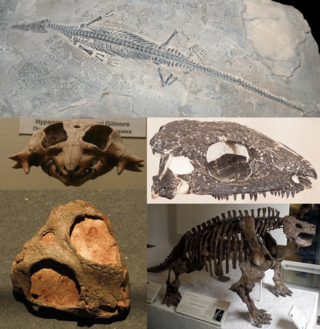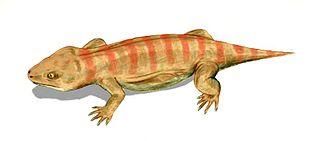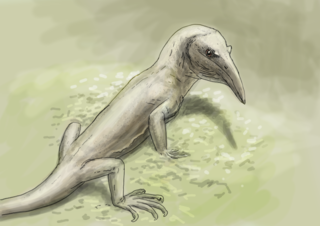
Parareptilia ("near-reptiles") is a subclass or clade of basal sauropsids/reptiles, typically considered the sister taxon to Eureptilia. Parareptiles first arose near the end of the Carboniferous period and achieved their highest diversity during the Permian period. Several ecological innovations were first accomplished by parareptiles among reptiles. These include the first reptiles to return to marine ecosystems (mesosaurs), the first bipedal reptiles, the first reptiles with advanced hearing systems, and the first large herbivorous reptiles. The only parareptiles to survive into the Triassic period were the procolophonoids, a group of small generalists, omnivores, and herbivores. The largest family of procolophonoids, the procolophonids, rediversified in the Triassic, but subsequently declined and became extinct by the end of the period.

The Procolophonia are a suborder of herbivorous reptiles that lived from the Middle Permian till the end of the Triassic period. They were originally included as a suborder of the Cotylosauria but are now considered a clade of Parareptilia. They are closely related to other generally lizard-like Permian reptiles such as the Millerettidae, Bolosauridae, Acleistorhinidae, and Lanthanosuchidae, all of which are included under the Anapsida or "Parareptiles".

Procolophonidae is an extinct family of small, lizard-like parareptiles known from the Late Permian to Late Triassic that were distributed across Pangaea, having been reported from Europe, North America, China, South Africa, South America, Antarctica and Australia. The most primitive procolophonids were likely insectiovous or omnivorous, more derived members of the clade developed bicusped molars, and were likely herbivorous feeding on high fiber vegetation or durophagous omnivores. Many members of the group are noted for spines projecting from the quadratojugal bone of the skull, which likely served a defensive purpose as well as possibly also for display. At least some taxa were likely fossorial burrowers. While diverse during the Early and Middle Triassic, they had very low diversity during the Late Triassic, and were extinct by the beginning of the Jurassic.

Procolophon is a genus of lizard-like procolophonid parareptiles that first appeared in the Early Triassic (Induan) of South Africa, Brazil, and Antarctica. It persisted through the Permian–Triassic extinction event, but went extinct in the beginning of the Early Middle Triassic. The type species is P. trigoniceps.

Leptopleuron is an extinct genus of procolophonid that lived in the dry lands during the late Triassic in Elgin of northern Scotland and was the first to be included in the clade of Procolophonidae. First described by English paleontologist and biologist Sir Richard Owen, Leptopleuron is derived from two Greek bases, leptos for "slender" and pleuron for "rib," describing it as having slender ribs. The fossil is also known by a second name, Telerpeton, which is derived from the Greek bases tele for "far off" and herpeton for "reptile." In Scotland, Leptopleuron was found specifically in the Lossiemouth Sandstone Formation. The yellow sandstone it was located in was poorly lithified with wind coming from the southwest. The environment is also described to consist of barchan dunes due to the winds, ranging up to 20 m tall that spread during dry phases into flood plains. Procolophonoids such as Leptopleuron were considered an essential addition to the terrestrial ecosystem during the Triassic.

Sclerosaurus is an extinct genus of procolophonid parareptile known from the Early to Middle Triassic of Germany and Switzerland. It contains a single species, Sclerosaurus armatus. It was fairly small, about 30 cm long, distinguished from other known parareptiles by the possession of long, backwardly projecting spikes, rear lower jaw teeth with slightly imbricating crowns, and a narrow band of back armor comprising two or three rows of sculptured osteoderms on either side of the midline.

Acleistorhinus (ah-kles-toe-RYE-nuss) is an extinct genus of parareptile known from the Early Permian of Oklahoma. It is notable for being the earliest known anapsid reptile yet discovered. The morphology of the lower temporal fenestra of the skull of Acleistorhinus bears a superficial resemblance to that seen in early synapsids, a result of convergent evolution. Only a single species, A. pteroticus, is known, and it is classified in the Family Acleistorhinidae, along with Colobomycter.
The Wolfville Formation is a Triassic geologic formation of Nova Scotia. The formation is of Carnian to early Norian age. Fossils of small land vertebrates have been found in the formation, including procolophonid and early archosauromorph reptiles and cynodonts. Dinosaur remains are among the fossils that have been recovered from the formation, although none have yet been referred to a specific genus.
Phonodus is an extinct genus of procolophonid parareptile. It is known from a single skull found from the Early Triassic Katberg Formation in South Africa. It is the oldest known member of the subfamily Leptopleuroninae, and was likely the result of a procolophonid migration into the Karoo Basin from Laurasia after the Permo-Triassic extinction event. Because Phonodus had large maxillary teeth underneath a large antorbital buttress, and a lack of ventral temporal emargination along the side of the skull, it probably had a durophagous diet.

Teraterpeton is an extinct genus of trilophosaurid archosauromorphs. It is known from a partial skeleton from the Late Triassic Wolfville Formation of Nova Scotia, described in 2003. It has many unique features seen in no other related form, including an elongated, toothless snout and large openings for the nostrils. Because of this, Teraterpeton was originally placed in its own family, Teraterpetidae, related to Trilophosaurus. Newer studies generally place it within Trilophosauridae.
Coletta is an extinct genus of basal procolophonid parareptile from Early Triassic deposits of Eastern Cape Province, South Africa. It is known from the holotype GHG 228, a skull with fragmentary lower jaws. It was collected on the farm Brakfontein 333 in the Cradock District. It was found in the Katberg Formation of the Beaufort Group and referred to the Lystrosaurus Assemblage Zone. It was first named by Christopher E. Gow in 2000 and the type species is Coletta seca.
Pintosaurus is an extinct genus of basal procolophonid parareptile from Late Triassic deposits of northeastern Uruguay. It is known from the holotype FC-DPV 1181, a partial skull. It was collected from the Buena Vista Formation of the Paraná Basin, in Colonia Orozco, Cerro Largo Department. It was first named by Graciela Piñeiro, Alejandra Rojas and Martín Ubilla in 2004 and the type species is Pintosaurus magnidentis. The generic name honours Dr. Iraja Damiani Pinto. The specific name means "with a large tooth" in Latin, a reference to the large palatal tooth pair.
Theledectes is an extinct genus of theledectine procolophonid parareptile from middle Triassic deposits of Free State Province, South Africa.The type species, Theledectes perforatus, is based on the holotype BP/1/4585, a flattened skull. This skull was collected by the South African palaeontologist, James W. Kitching from Hugoskop in the Rouxville District and referred to subzone B of the Cynognathus Assemblage Zone of the Burgersdorp Formation, Beaufort Group. The genus was first named by Sean P. Modesto and Ross J. Damiani in 2003. However, the species was initially assigned to the genus Thelegnathus by C.E. Gow in 1977, as the species Thelegnathus perforatus.
Theledectinae is an extinct subfamily of parareptiles within the family Procolophonidae. Theledectines existed in South Africa, China and Australia during the Early-Middle Triassic period. Theledectinae was named by Juan Carlos Cisneros in 2008 to include the genus Theledectes, and the species "Eumetabolodon" dongshengensis. "E." dongshengensis represents a new genus from China. Cladistically, it is defined as "All taxa more closely related to Theledectes perforatus than to Procolophon trigoniceps Owen, 1876". In 2020, Hamley add the new genus Eomurruna from Australia to this subfamily
Phaanthosaurus is an extinct genus of basal procolophonid parareptile from early Triassic deposits of Nizhnii Novgorod, Russian Federation. It is known from the holotype PIN 1025/1, a mandible. It was collected from Vetluga River, Spasskoe village and referred to the Vokhmian terrestrial horizon of the Vokhma Formation. It was first named by P. K. Chudinov and B. P. Vjushkov in 1956 and the type species is Phaanthosaurus ignatjevi.
Pentaedrusaurus is an extinct genus of procolophonid parareptile from the Early Triassic of China. It is one of the most basal members of the procolophonid subfamily Leptopleuroninae. The only known species of Pentaedrusaurus, P. ordosianus, was named in 1989 from the Heshanggou Formation.

Kapes is an extinct genus of procolophonid parareptile from the Lower and Middle Triassic of the United Kingdom and Russia. It is a member of the subfamily Procolophoninae. The type species K. amaenus was named in 1975 from the banks of the Vychegda River in the Komi Republic of Russia. In 1983, a new species was brought into the genus, K. majmesculae. K. majmesculae was first named in 1968 as a member of the genus Tichvinskia. A third Russian species, K. serotinus, was named in 1991. In 2002, Kapes bentoni was named from the Middle Triassic Otter Sandstone Formation of Devon, England, extending the geographic range of Kapes. In the same paper, K. serotinus was synonymized with K. majmesculae and another Russian species was assigned to Kapes called K. komiensis. K. komiensis was first named in 1975 as a member of the genus Macrophon.
Libognathus is an extinct genus of procolophonid parareptile from the Late Triassic of Texas. The type and only species, Libognathus sheddi, was named in 1997 from the Cooper Canyon Formation in the fossil-rich Post Quarry, which is found in Garza County. Libognathus was the first definite procolophonid discovered in the southwestern United States, although another possible procolophonid called Chinleogomphius was reported from the southwest before Libognathus was named.
Barasaurus is an extinct genus of owenettid procolophonoid parareptile known from the Late Permian and Early Triassic of Madagascar. It contains a single species, Barasaurus besairiei.
Oryctorhynchus is an extinct genus of rhynchosaur from the Late Triassic (Carnian-Norian)-aged Wolfville Formation of Nova Scotia, Canada that may have been the same animal as Beesiiwo. The type species, O. bairdi, was named and described in 2020. It was originally seen as a species of Hyperodapedon until 2020.














